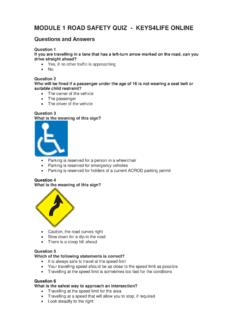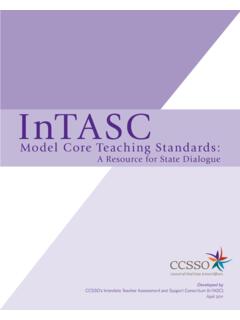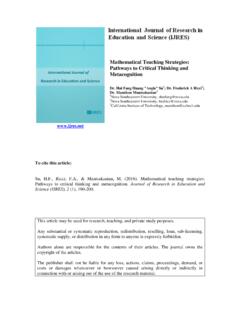Transcription of Teaching and Learning Strategies - SDERA
1 Teaching and Learning strategiesTEACHING AND LEARNINGSTRATEGIESI ntroduction Overview ..291 Using the Teaching andlearning Strategies ..291 Selecting Teaching andlearning Strategies ..292 Tuning in Before and after ..293 Card Graffiti ..294 KWL ..295 One minute Question partners ..295 Quiz ..296 Finding out Brainstorm ..298 Circle talk ..298 Head Jigsaw ..299 Placemat ..300 Rip and review ..300 Scavenger Simulated ..301 Surveys ..302 Viewing ..302 Sorting out Mind maps ..304 90 degree thinking ..304 T and Y charts.
2 305 Venn diagram ..305 Written responses ..306 Developing values Choose a corner ..308 My attitude my actions ..308 Oxford style debate ..309 Values continuum ..309 Values voting ..310 making decisions decision - making model ..312 Fortune Helpful and positive Hypothetical ..314 PNI ..314 Problem predicting ..315 Send a problem ..317 Snap decisions ..317 Speaking out Chook house speeches ..324 Health Think-pair-share ..325 Toss a die ..325 Vox pop interviews ..326 Reflecting Reflective questions ..327 Thought shapes.
3 327 3-2-1 Unfinished sentences ..328 TABLE OF CONTENTST eaching and Learning strategies291 Teaching and Learning strategiesStrategiesTeaching and Learning strategiesOverview of Teaching and Learning Strategies The Strategies described in this section of the resource represent well-recognised andeffective Teaching practices for early adolescence education. They promote critical andreflective thinking, research, evaluation and collaborative Learning and also focus onliteracy skills. The Strategies have been designed to accommodate differences in learningstyles and reflect contemporary Learning theory including Gardner s Multiple IntelligenceTheory and the revised Bloom s Taxonomy.
4 The Strategies have been divided according to the basic elements of an inquiry elements are also fundamental to the decision - making process in the Health andPhysical Education Self-management Skills Learning Outcome. The sections and focusof each are as follows:These Strategies ..Tuning be used to determine students current knowledge, skills andattitudes prior to planning a program. They will engage and focusstudents in the Learning experiences and content. Finding encourage investigation and independent Learning about keyhealth and safety encourage the analysis, organisation, review and reflection allow students to identify, discuss and develop positive attitudestowards safer and health provide opportunities for students to develop decision -makingskills to enable them to make safer and healthier provide opportunities for students to develop the communicationand negotiation skills required for safer healthier allow students to identify, discuss and consider the changes intheir understandings, attitudes and values.
5 Using the Teaching and learningstrategiesThe Teaching and Learning Strategies are used toengage students in the resilience, drug and roadsafety content of this resource. The Strategies have been boldedwithin the textof a Learning experience (see illustration). Teachers should refer to this section of theresource for an explanation of the purpose andhow to implement the strategy with their and Learning strategiesTeaching and Learning strategiesSelecting Teaching and learningstrategiesThe Teaching and Learning Strategies have beenlinked to Learning experiences described in each unitof this resource. Teachers are encouraged to usetheir professional judgement to review the suggestedstrategies and then decide on the most appropriatefor meeting the needs of their students and deliverthe essential content in either a resilience, drug orroad safety should also consider the appropriatenessof the Strategies for students after reading the Scopesection (pp.)
6 29-30) and the Principles of Learning , Teaching and Assessment (pp. 134-9) of theCurriculum Learning strategiesThe Learning Strategies linked to learningexperiences are a suggestion only. As teachersknow their students Learning styles and needs theymay need to select alternative Teaching and learningstrategies or adapt those suggested to deliver thecontent. For example: a think-pair-sharehas been suggested as aspeaking out strategy in this resource. It caneasily be adapted for students to use when sortingout or reflecting on information gained during alearning experience. a placemathas been suggested as a Finding outstrategy in this resource.
7 It can also be used totune students into a new concept or to considerinformation when making students Learning styles and needsWhen teachers are asked to cater for individualdifferences it does not mean that every student mustbe given an individual work program or thatinstruction must be on a one-to-one basis. Whenteaching and Learning is individualised it is reflectedin classroom organisation, curriculum andinstruction. Teaching and Learning Strategies caninclude a range of whole class, group and individualactivities to accommodate different abilities, skills, Learning rates and styles that allow every student toparticipate and to achieve some degree of success.
8 After considering students needs, Learning stylesand levels of achievement in relation to the learningoutcomes, it is important to select Strategies : focusing on the development of knowledge, skillsand attitudes that will assist students to engage in the essentialcontent that will support and extend Learning that will enable students to make progress in theirachievement and maximise their accomplishmentof the Learning outcomes. Being inclusive of all students All students are able to learn. However, the learningrate for students with disabilities or severe learningdifficulties may be influenced by nature, the severityof their disability or their access and interaction withthe environment.
9 Individualised educationalprograms may be needed in order for these studentsto demonstrate particular in The Strategies included in this section are: Before and after Card clusters Graffiti KWL One minute challenge Question partners QuizWhat is tuning in? Tuning in Strategies provide the opportunity for students to explore their currentknowledge, attitudes and values about health and safety issues. While workingindependently or collaboratively, students can use suggested graphic organisers torecord and share will be able to use evidence gathered from students responses to plan aprogram to cater for the needs of all and Learning strategiesTuning inTuning inBefore and afterThis strategy will help students to: consider and reflect on their own and others current knowledge, skills, beliefs and attitudes identify changes in their own knowledge, skills,beliefs and is it implemented?
10 1. Devise a set of statements or questions that willidentify students understanding, beliefs andattitudes towards health or safety issues andwrite these on Resource Sheet 1: Before focus may be on one issue ( ) or a range of issues (see the exampleprovided below).2. Ask students to respond to eachstatement/question before commencing a unit orfocus area. Collect the resource Have students complete the after column whenthey have participated in one or several of thelearning experiences in the unit or focus In pairs or small groups, ask students to reflecton any changes in their understanding orattitudes towards the issue.





